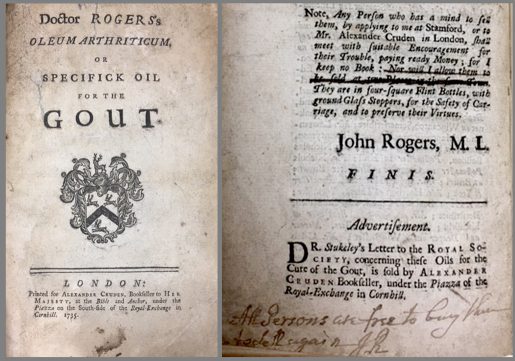Jacques-Fabien Gautier D’Agoty (1717-1785), the French anatomist and printmaker, produced his first color printed image of a shell in 1737. He started color printing by making reproductions of oil paintings, but soon turned to producing color-printed images for science. Between 1745 and 1785, he produced more than a dozen illustrated works on anatomy and physics. His cooperation with anatomist Joseph-Guichard Duverney resulted in the publication of three anatomy atlases. After the anatomist’s death, Gautier himself took over the anatomical dissections and demonstrations used for later works. He provided color plates for many periodicals. As a member of the Académie des Sciences, Arts et Belles-Lettres de Dijon, he used his scientific activity to promote his business. His entrepreneurial skills made his printing atelier into a successful family enterprise. He and all of his five sons were influential members of printing and artistic communities in Paris in the mid-18th century. Continue reading
treasures-rare-book-room
Treasures from the Rare Book Room: Gautier D’Agoty and His Color Prints, Part 1
The artist, Jacques-Fabien Gautier, later known as Gautier D’Agoty (1717-1785), was a French painter, engraver, and printer who moved to Paris around 1735. In the French capital, he briefly worked as an assistant to Jacob Christoph Le Blon, the inventor of a three-color printing process using red, yellow, and blue plates. After Le Blon’s death in 1741, Gautier not only took over the business, but he also successfully claimed the title of “inventor of color printing.” He secured the royal privilege and funding for his own printing endeavor to prove it. The basis of his claim was that in addition to the three plates of colors used by Le Blon, he introduced a fourth, black plate. He further refined the technique by switching the order in which the colors were applied.
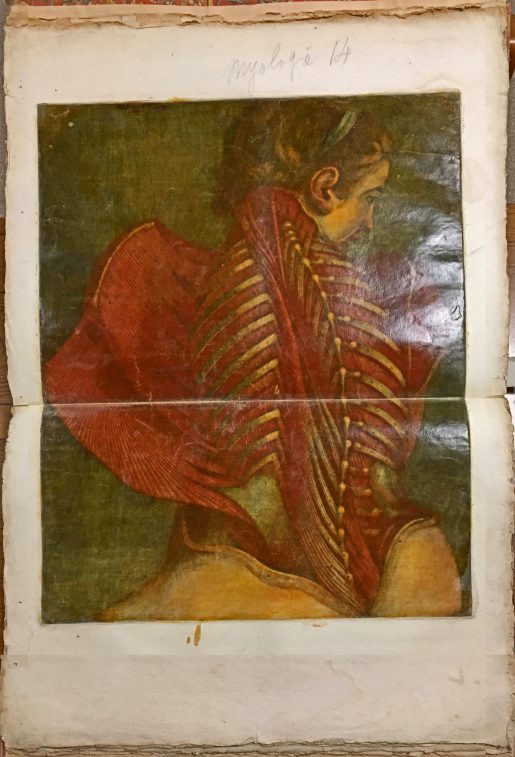 The “Flayed Angel” (also known as the “Anatomical Angel”) comes from Myologie Complete (1746), an anatomical atlas by Gautier D’Agoty. The large color plate (46 cm x 60 cm), printed across two folio leaves, is one of the biggest illustrations in the Falk Library collection. In it, a woman appears alive despite the fact that the dissector pulled away muscles like wings to reveal her spine. This beautiful rendering of a dissected body is one of 20 illustrations produced by this new printing technique, which consisted of a base etching and a mezzotint engraving of a copper or metal plate in which four separate impressions were made from black, red, yellow, and blue plates to give the final image its colors. Continue reading
The “Flayed Angel” (also known as the “Anatomical Angel”) comes from Myologie Complete (1746), an anatomical atlas by Gautier D’Agoty. The large color plate (46 cm x 60 cm), printed across two folio leaves, is one of the biggest illustrations in the Falk Library collection. In it, a woman appears alive despite the fact that the dissector pulled away muscles like wings to reveal her spine. This beautiful rendering of a dissected body is one of 20 illustrations produced by this new printing technique, which consisted of a base etching and a mezzotint engraving of a copper or metal plate in which four separate impressions were made from black, red, yellow, and blue plates to give the final image its colors. Continue reading
Treasures from the Rare Book Room: An Early Ophthalmology Text
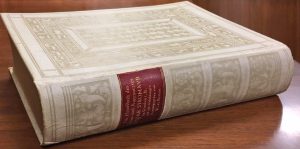 The book, Die Handschrift des Schnitt- und Augenarztes Caspar Stromayr in Lindau im Bodensee (Berlin 1925), in Falk Library’s Rodnan Room, is neither very old nor very rare. Its importance is that it brings to our attention an early ophthalmology text by Caspar Stromayr that was never published before.
The book, Die Handschrift des Schnitt- und Augenarztes Caspar Stromayr in Lindau im Bodensee (Berlin 1925), in Falk Library’s Rodnan Room, is neither very old nor very rare. Its importance is that it brings to our attention an early ophthalmology text by Caspar Stromayr that was never published before.
Caspar Stromayr was a 16th century German surgeon and ophthalmologist. A contemporary of Vesalius and Paré, he probably had some academic education, but mostly he achieved highly specialized knowledge through reading, consultations with other physicians, and empirical observations while practicing as a town surgeon in his native town of Lindau. He died there around 1566. In his lifetime, he did not influence 16th century medicine, his skills and knowledge were forgotten, and his eloquent unpublished work was buried in the library for almost 400 years. Today, however, he stands out among his contemporaries thanks to the manuscript he left behind.
His Practica Copiosa mostly deals with the surgery of hernia, to which there are two appended chapters on the surgery of the eye. The latter might have been intended to be a separate work, because the illustrations do not align with the original text, which has blanks where the illustration figures should be. Stromayr’s observations and thoughts were original and ahead of his time. The appended chapters on the etiology of cataracts and their treatment are of special importance because they are the first German ophthalmology work of known authorship.
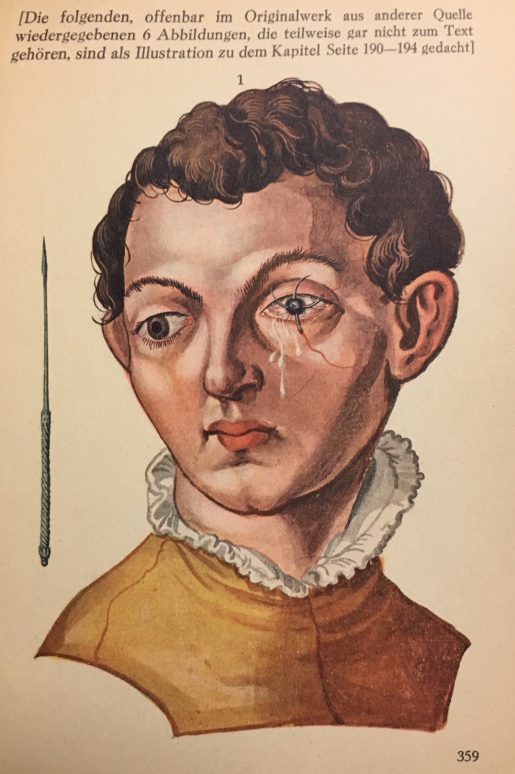 The richly illustrated manuscript was brought to light in 1925, when it was published by surgical historian Walter von Brunn. The English translation makes the text even more accessible. Nine out of 186 plates relate to the ophthalmology chapters. The plate presented on the right shows the eye with mature cataract undergoing a procedure with a threaded curved needle.
The richly illustrated manuscript was brought to light in 1925, when it was published by surgical historian Walter von Brunn. The English translation makes the text even more accessible. Nine out of 186 plates relate to the ophthalmology chapters. The plate presented on the right shows the eye with mature cataract undergoing a procedure with a threaded curved needle.
An exhibit on the history of cataract surgery is currently on display in the Falk Library lobby.
~Gosia Fort
Treasures from the Rare Book Room: Befriend That Bear!
 John K’eogh (1681-1754) was an Irish naturalist and the author of Botanologia Universalis Hibernica (1735), an early Irish herbal, and Zoologia Medicinalis Hibernica (1739). His intent with both works was to show that his country was self-sufficient to produce all remedies to cure the locals of any sickness without the need to import foreign medicines.
John K’eogh (1681-1754) was an Irish naturalist and the author of Botanologia Universalis Hibernica (1735), an early Irish herbal, and Zoologia Medicinalis Hibernica (1739). His intent with both works was to show that his country was self-sufficient to produce all remedies to cure the locals of any sickness without the need to import foreign medicines.
Zoologia Medicinalis Hibernica, owned by Falk Library, is quite rare. It is bound in a modern Morocco leather, with gilded lettering on the spine. The paper used by the Irish printer might have come from the local mill, but one used by a binder has a clearly visible watermark of “Maid of Dort” which ties in to a Dutch master papermaker of the 18th century.
The book on the medicinal virtues of animals, written before the standardization of FDA regulations or the need to prove efficacy, offers information on remedies in a typical hearsay fashion for the times. K’eogh is familiar with medical classics. He cites Galen, Avicenna, and Rhases. He also refers to earlier naturalists such as Pliny the Elder, Albertus Magnus, Johann Hartmann, Jan Jonston, Ulisse Aldrovandi, and others. Continue reading
Treasures from the Rare Book Room: Doctor Rogers’s Oleum Arthriticum
The Gout Collection at Pitt is the legacy of Gerald Rodnan (1927-1983), a former professor at the School of Medicine. Among its many rarities is a small leaflet, Doctor Rogers’s Oleum Arthriticum or Specific Oil for the Gout, published in 1735.
John Rogers was a respected apothecary in Stamford, Lincolnshire, and a licensed physician. He came upon a successful combination of oils in 1729. After testing it on himself, he treated several local fellow gout sufferers. William Stukeley, a physician and scholar well known in London circles, observed the success of Rogers’ medication. He gave an account of it to the Royal Society in London in 1733 (A letter to Sir Hans Sloan […] of the Royal Society about the cure of the gout…) and wrote Treatise of the Cause and Cure of the Gout (1734). The endorsement was powerful.
Doctor Rogers’s Oleum Arthriticum is an advertisement of the oils written in the form of letters between two gentlemen: one from London who successfully used Rogers’ treatment, the other from Dublin who learned about the cure from Stukeley’s book and decided to self-medicate based on Stukeley’s powerful endorsement. The letters are followed by additional directions for a regimen, in which Rogers recommends to vomit, bleed, and purge to enhance the work of the oils. He also includes information on pricing and the distribution of the medicine.
The unassuming leaflet bound in a simple contemporary paper hardcover has a handwritten dedication to Gerald P. Rodnan from Stewart C. Reed on the inside back cover and the collector’s bookplate on the inside front cover. It is very scarce, as most ephemeral prints are. Only four libraries in the United States appear to own a copy. What makes our item unique is the author’s handwritten note added on the last page. The printed statement Nor will I allow them to be sold at two Places in the same Town is crossed out and a new note added at the bottom: All Persons are free to buy these to sell again – J R.
The book can be seen in the Rare Book Room by appointment. For more information, please send an e-mail to techserv@pitt.edu
~ Gosia Fort
Treasures from the Rare Book Room: Golgi’s Investigations on the Finer Structure of the Central and Peripheral Nervous System
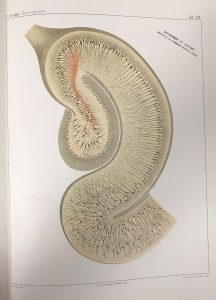
Camillo Golgi (1843-1926) was an Italian pathologist associated with the University of Pavia, where he studied and worked as professor of histology, chair of pathology, and dean and rector of the University. He is known for his work on the central nervous system, for which he was awarded the Nobel Prize in Physiology or Medicine in 1906, and which he shared with Santiago Ramón y Cajal.
While studying at the University of Pavia, under the influence of Cesare Lombroso, Golgi started his scientific career researching mental diseases, but quickly abandoned psychiatry in order to study the structure of the nervous system. Though tissue staining techniques in histological research were introduced in the mid-19th century, they were not sophisticated enough for investigating the nervous system. Golgi started his search for a better technique and ultimately discovered staining using potassium dichromate and silver nitrate (mentioned by him in 1873). This revolutionary technique of “black reaction,” later named after him (Golgi staining or Golgi impregnation), allowed for the first time a clear visualization and description of nerve cells. This discovery was a critical point in the development of modern neurology. Though Golgi himself could not see beyond the “reticular theory” (the belief that the nervous system consists of nervous fibers forming an intricate but continuous network), his work led to the establishment of neurons as a basic cell unit of the nervous system. He will be remembered as a man who pushed neurological research forward. Continue reading
Treasures from the Rare Book Room: Apostle of the Lepers
Saint Damien of Moloka’i, born Jozef De Veuster in Belgium in 1840, was a Roman Catholic priest who devoted his life to missionary work among the lepers in Hawaii. Jozef chose a religious life over the family farm. As soon as he was old enough, he joined the Congregation of the Sacred Hearts of Jesus and Mary and took the name Damien. In 1864, he traveled to Hawaii where he was ordained a priest and worked there for nine years. Moved by the fate of lepers deported by the government to Moloka’i Island, he volunteered to take charge of the settlement in Kalaupapa in 1873. The colony had no medical care or medicines. The lack of provisions, supplies, fresh water, and hygiene made living conditions harsh, but Father Damien stayed with his flock for 16 years, until his death in 1889. He was a voice to the authorities in Honolulu, organizing, building housing, helping, and caring for the sick. He was their spiritual leader, friend, and physician. According to his wishes, he was buried in Hawaii, but in 1936 his body was moved to his home country.
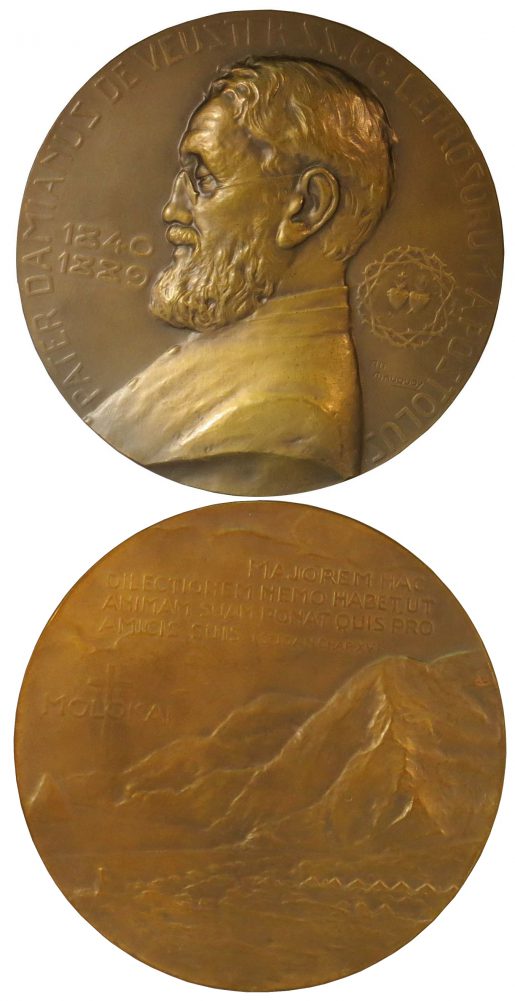 A commemorative medal—shown here—was struck on this occasion the same year. It is part of the HSLS Medical and Scientific Medals Collection. It was designed by Belgian medalist and sculptor, Alfonse Mauquoy. The medal shows Father Damien, “Apostle of the Lepers,” on one side and the Hawaiian landscape of Kaluapapa Peninsula on the other. The Biblical quote, “Greater love has no one than this, that one lay down his life for his friends,” chosen as part of the design is quite appropriate since Father Damien contracted the disease while caring for the lepers. Because of this, he was accused of immorality which inspired Scottish author Robert Louis Stevenson to visit the colony and write his passionate defense of the priest. Damien was exonerated and his lifetime of service to the sick was rewarded when he was canonized in 2009.
A commemorative medal—shown here—was struck on this occasion the same year. It is part of the HSLS Medical and Scientific Medals Collection. It was designed by Belgian medalist and sculptor, Alfonse Mauquoy. The medal shows Father Damien, “Apostle of the Lepers,” on one side and the Hawaiian landscape of Kaluapapa Peninsula on the other. The Biblical quote, “Greater love has no one than this, that one lay down his life for his friends,” chosen as part of the design is quite appropriate since Father Damien contracted the disease while caring for the lepers. Because of this, he was accused of immorality which inspired Scottish author Robert Louis Stevenson to visit the colony and write his passionate defense of the priest. Damien was exonerated and his lifetime of service to the sick was rewarded when he was canonized in 2009.
Both the medal and the reprint of Stevenson’s letter are currently on display in the Falk Library lobby. For more information, contact HSLS Collections & Digital Library Services.
~Gosia Fort
Treasures from the Rare Book Room: “Mean Genius” Antonio Scarpa
Antonio Scarpa (1752-1832) was an Italian anatomist, excellent surgeon, polished writer, and medical illustrator. During his tenure at the University of Pavia, it became the leading educational institution in Europe for the study of anatomy. Scarpa pioneered a program of anatomical demonstrations and required students to learn by practicing dissections on their own. As Rector, he was more the dictator of the University than its leader. His ruthless demeanor earned him no friends. He was feared by students and colleagues alike. There are many stories illustrating this behavior: for example, when he was working on illustrations for his Tabulae Neurologicae, he locked his engraver in the room until the work was finished. When he died, nasty verse defaced his statue in Pavia:
Scarpa is dead;
And I should care.
He lived like a hog.
And died like a dog.
Since he did not leave a family, his assistant performed his dissection and preserved the professor’s head as a specimen for the University. It is still on display today at the Museo per la Storia dell’Università di Pavia.
 Although he was not a loveable person, his innovative teaching methods, and the excellent books he authored, earned him the respect of the medical profession. He is remembered as a great surgeon, anatomist, and discoverer of the naso-palatine nerve. His study of the hearing and olfactory organs is considered classic. He was the first to correctly delineate the nerves of the heart. In his authoritative works on hernia, he described perineal hernia from direct observations, thus settling any earlier controversy of its existence. His work, Saggio di osservazioni e d’esperienze sulle principali malattie degli occhi (Practical observations on the principal diseases of the eyes, 1806), raised ophthalmology to the level of an autonomous science. Plate I from this work is one of the most famous illustrations in medicine, in which science and art become one.
Although he was not a loveable person, his innovative teaching methods, and the excellent books he authored, earned him the respect of the medical profession. He is remembered as a great surgeon, anatomist, and discoverer of the naso-palatine nerve. His study of the hearing and olfactory organs is considered classic. He was the first to correctly delineate the nerves of the heart. In his authoritative works on hernia, he described perineal hernia from direct observations, thus settling any earlier controversy of its existence. His work, Saggio di osservazioni e d’esperienze sulle principali malattie degli occhi (Practical observations on the principal diseases of the eyes, 1806), raised ophthalmology to the level of an autonomous science. Plate I from this work is one of the most famous illustrations in medicine, in which science and art become one.
Falk Library has a facsimile of the ophthalmology book and all Scarpa’s original works on hernias including the English, French, and German translations. These materials can be viewed in the Rare Book Room by appointment.
~ Gosia Fort
On Borrowed Time: Pulp Fiction Treasures in Falk Library
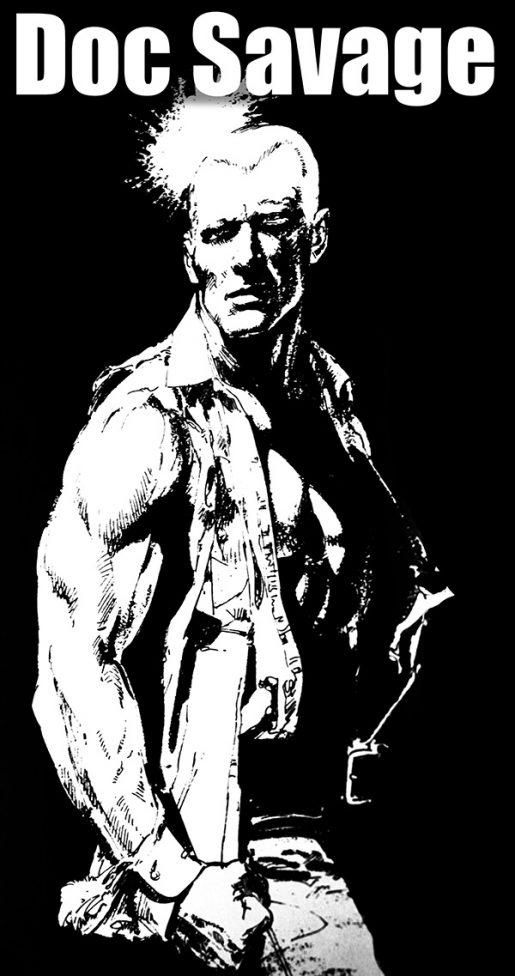
Falk Library has recently opened a new exhibit of signed prints, original artwork, and published comics titled “Doc Savage: The Supreme Adventurer and Physician.” The featured items are on temporary loan to the library from a private collection.
Doc was a nickname of Clark Savage Jr., MD, a physician and scientist who “practiced” his medicine under the most challenging circumstances and in the most unusual places. He traveled the world, along with his six aides, battling against sinister crime lords and evil geniuses. Doc’s adventures have captivated generations of readers and inspired many illustrators. He was, according to Marvel icon Stan Lee, the forerunner of all modern superheroes.
Treasures from the Rare Book Room: De Morbis Capitis
In 1650, Robert Pemell’s De Morbis Capitis, or, Of the Chief Internal Diseases of the Head, was published in London. According to Alan Pestronk (Archives of Neurology 46, no. 2 (1898): 215-220), this was the first neurology book written in English. A country physician from Cranebrooke, Kent, Pemell (died 1653) would be completely forgotten if not for the writings he left behind. Continue reading
Treasures from the Rare Book Room: Withering on Foxglove
 William Withering (1741-1799) was a British polymath, botanist, mineralogist, and chief physician at the Birmingham General Hospital. He attracted the attention of the medical world to the virtues of common foxglove (also known by its Latin name, digitalis) in the treatment of dropsy when he published his famous work, An Account of the Foxglove, and Some of Its Medicinal Uses, in 1785. Continue reading
William Withering (1741-1799) was a British polymath, botanist, mineralogist, and chief physician at the Birmingham General Hospital. He attracted the attention of the medical world to the virtues of common foxglove (also known by its Latin name, digitalis) in the treatment of dropsy when he published his famous work, An Account of the Foxglove, and Some of Its Medicinal Uses, in 1785. Continue reading
Treasures from the Rare Book Room: Before National Pharmacopeias Were Born…
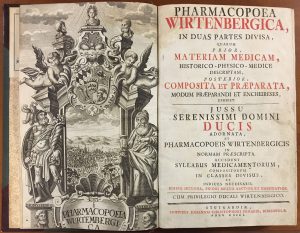
A pharmacopeia, in the modern sense, is a list of drugs and medicinal preparations, serving as an authoritative source of identification and a standard to be followed. Before the emergence of these works, however, medicines were described together with other treatments as part of general medical texts. Some were depicted in herbals and others in the materia medica books, with traditional medical remedies.
The first real pharmacopeia was, Pharmacorvm Omnivm, published by Valerius Cordus in 1546. Recognized as the official standard in Nurenberg, it inspired a chain reaction as many other European cities published their own local pharmacopeias. By the mid-17th century, this movement reached its peak, and the need to expand the jurisdiction of disparate pharmacopeias resurfaced. This eventually led to development of a standard for an entire country. The Pharmacopeia of the United States of America (Boston 1820) exemplifies this trend.
Publication of the Pharmacopœia Londinensis in 1618, a work widely disseminated in Europe through a multitude of foreign reprints, translations, and adaptations, illustrates another important aspect: authority. Backed by the Royal College of Physicians, the creation of this pharmacopeia was no longer one author’s responsibility. As time passed, institutional authority gradually shifted from societies (“colleges”) of physicians, to societies of pharmacists, or to governments responsible for producing national pharmacopeias.
The 18th century brought another important trend in the development of the modern pharmacopeia: an increased focus on scientific evidence. This was triggered by progress in the sciences, especially chemistry. It led to a reduction of listing remedies associated with superstitions or customs, and to greater interest in the testing of drugs. All of these changes happened slowly, and though the displacement started in the Age of Enlightenment, some traditional medicinal remedies persisted in pharmacopeias until the late 19th century.
Falk Library has original or facsimile editions of the texts mentioned above along with the beautifully preserved Pharmacopoea Wirtenbergica (Stuttgart 1750) pictured here. It served as a standard for the Duchy of Württemberg. This book is an example of a pharmacopeia combining a formulary and a textbook giving comprehensive information about the materia medica in addition to the required listings.
For more information or to view these volumes, e-mail techserv@pitt.edu or call 412-383-9773.
~Gosia Fort
United in Illness: Gómez Miedes’ Enquiridion
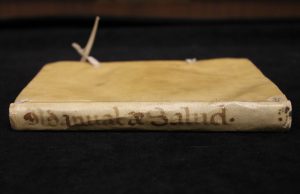 Bernardino Gómez Miedes (1520-1589) was a Spanish humanist well-versed in many disciplines. He authored two important books: Commentarii de sale (1572), the earliest discussion of salt, and Enchiridion (1589), a manual about gout. An edition of the latter, published again in Madrid in 1731, caught the eye of Dr. Gerald Rodnan. Dr. Rodnan was an avid book collector, professor of medicine, and the former division chief of rheumatology and clinical immunology at the University of Pittsburgh, who donated his impressive collection of rheumatology books to the Falk Library.
Bernardino Gómez Miedes (1520-1589) was a Spanish humanist well-versed in many disciplines. He authored two important books: Commentarii de sale (1572), the earliest discussion of salt, and Enchiridion (1589), a manual about gout. An edition of the latter, published again in Madrid in 1731, caught the eye of Dr. Gerald Rodnan. Dr. Rodnan was an avid book collector, professor of medicine, and the former division chief of rheumatology and clinical immunology at the University of Pittsburgh, who donated his impressive collection of rheumatology books to the Falk Library.
The 1731 edition of Enquiridion is bound in limp vellum, which was the traditional and common choice of binders in the 18th century. The white leather of the cover is not decorated and has only a handwritten spine title, Manual de salud (Health Handbook). The strips of leather supporting the spine and forming the closing ties are visible though no longer functional. Typical for the period was also the use of pages from other, usually older, books. However, the binder of our library copy took a different approach by including as end papers pages 245-246 of a contemporary Spanish medical tract, Restauracion de la medicina antigua, sobre sus mayores remedios, by Francisco Suárez de Rivera, also published in 1731.
Enquiridion was originally published in 1589. It was written in Spanish, therefore destined for a wider domestic audience than a manual written in Latin. It was dedicated to Phillip II with the intention to advise the king, who like Gómez Miedes suffered from gout, on ways to deal with pain caused by the disease. The author was not a physician, but his book shows his erudition, proves his knowledge of ancient authors like Galen, and stresses the importance of clinical observation. He introduces massage as a healing technique. Gomez Miedes’ advice on dealing with pain in illness would have been especially convincing to his contemporaries, as it came from a fellow sufferer of gout.
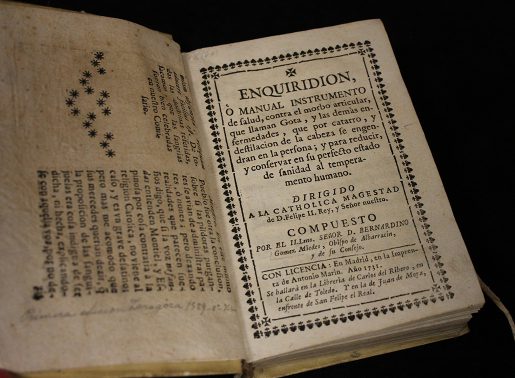
~Gosia Fort
Treasures from the Rare Book Room: Scrapbooks
 The idea of preserving memories, special moments, and histories in albums using scraps such as prints, bookplates, quotes, poems, calling cards, paper cutouts, press clippings, and photographs is not a new concept. In the United States, with the invention of photography and the appearance of a variety of patented photography and scrapbook albums, scrapbooking gained popularity in the 19th century. Today’s renewed interest in genealogy keeps the art of scrapbooking alive.
The idea of preserving memories, special moments, and histories in albums using scraps such as prints, bookplates, quotes, poems, calling cards, paper cutouts, press clippings, and photographs is not a new concept. In the United States, with the invention of photography and the appearance of a variety of patented photography and scrapbook albums, scrapbooking gained popularity in the 19th century. Today’s renewed interest in genealogy keeps the art of scrapbooking alive.
Falk Library has several interesting scrapbooks in its collections. There are albums from the School of Dentistry and the Western Psychiatric Institute and Clinic documenting Pitt’s contributions to research in related disciplines as well as illustrating special dentistry collections focused on the history of anesthesia. Other impressive topics include: a volume on curious customs, miracles and psychic occurrences, and three scrapbooks on the supernatural with newspaper clippings from the 1920s and 1930s on vampires, fortune tellers, human sacrifices, and magic. There are also two unique albums from the 27th Base Hospital in Angers during WWI and 27th General Hospital in New Guinea during WWII. Finally, there is a scrapbook honoring Lillian Clayton.
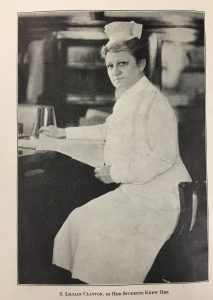 Sarah Lillian Clayton (1874-1930) was a nurse and a Superintendent of Nurses at Philadelphia General Hospital (PGH). She graduated from PGH Training School of Nursing in 1896 and began a nursing career that took her to Dayton, Minneapolis, and Chicago, only to return and complete her career in Philadelphia where she started. She became a national leader in nursing education, active in many organizations, and served as president of the National League for Nursing Education (1917-1920) and the American Nurses Association (1926-1930).
Sarah Lillian Clayton (1874-1930) was a nurse and a Superintendent of Nurses at Philadelphia General Hospital (PGH). She graduated from PGH Training School of Nursing in 1896 and began a nursing career that took her to Dayton, Minneapolis, and Chicago, only to return and complete her career in Philadelphia where she started. She became a national leader in nursing education, active in many organizations, and served as president of the National League for Nursing Education (1917-1920) and the American Nurses Association (1926-1930).
Clayton’s scrapbook was prepared by Florence Anna Ambler (Hay), one of her students and acolytes in 1930. It is a tribute to the distinguished nurse and includes photographs, press clippings, and typescripts of correspondence to and from Miss Clayton. In 1958, the scrapbook was donated to the University of Pittsburgh School of Nursing. Today it can be viewed in the Rare Book Room by appointment.
~Gosia Fort
